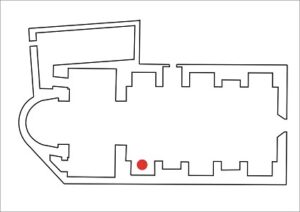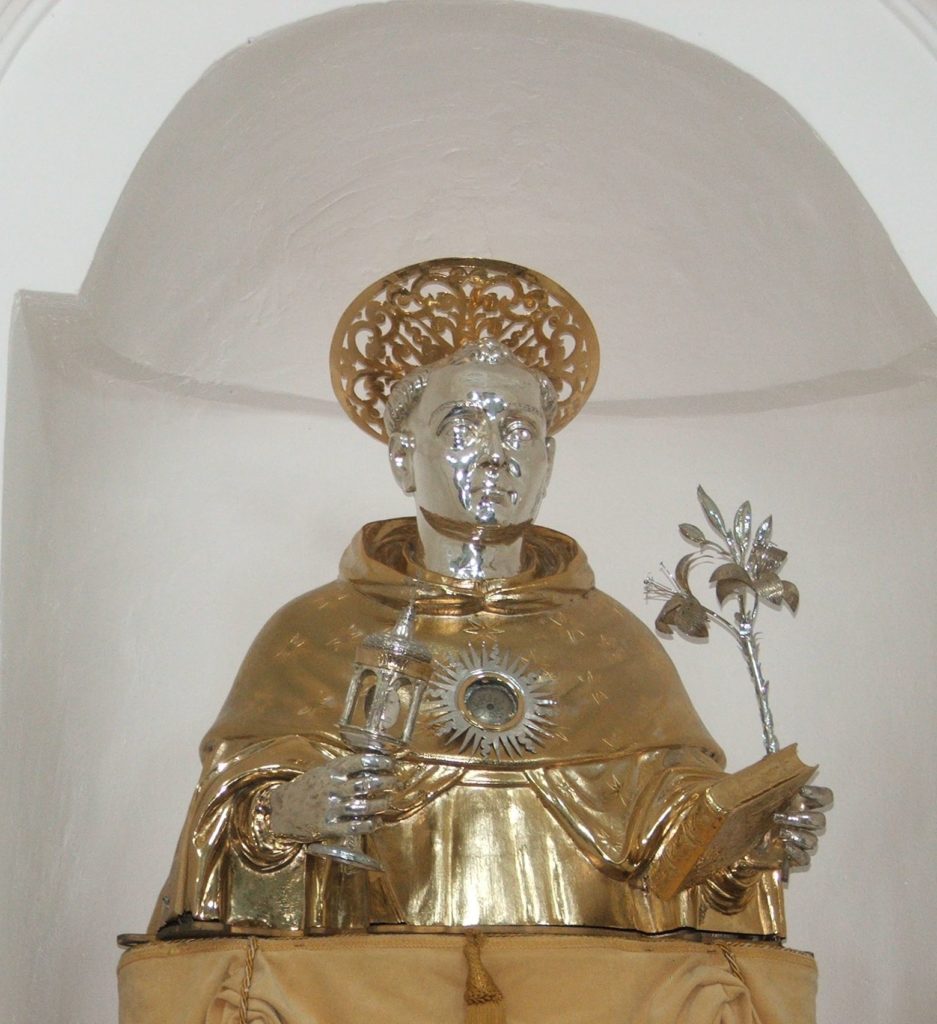San Tommaso d’Aquino


Chiesa di S. Maria Maggiore
Busto reliquario
San Tommaso d’Aquino
Sec. XVII (prima metà)
Ottone e argento sbalzato/cesellato/ fuso
Ambito culturale napoletano

Church of S. Maria Maggiore
Reliquary bust
Saint Thomas Aquinas
17th century (first half)
Embossed/ chiseled/ cast brass and silver.
Neapolitan cultural sphere
Il busto di San Tommaso d’Aquino, in metallo prezioso, è l’immagine più antica del Santo conservata nella comunità grottese .
Il manufatto artistico è documentato per la prima volta in un inventario composto tra l’ottobre e il novembre 1659 dall’arciprete Giovanni Grasso di Ariano Irpino: «Una statua di San Tommaso d’Aquino, che si conserva nella stanza che si dice lo studio di San Tommaso: la testa e mani d’argento, il giglio d’argento, l’ostiario tiene nelle [mani] d’ottone indorato et argento, lo libro, diadema».
La tipologia del manufatto rimanda ai busti d’argento dei santi patroni di Napoli, conservati nella Cappella del Tesoro del Duomo della città partenopea e ai busti reliquiari di Montevergine. Nello specifico, il busto di Grottaminarda è assimilabile al busto del San Tommaso, realizzato nel 1628 da Francesco Buccamando per volere di Carlo d’Aquino, per la Chiesa di San Domenico Maggiore di Napoli, scomparso in età napoleonica, ma di cui si conserva il bozzetto in creta a Lamezia Terme.
Il busto venne probabilmente realizzato in epoca compresa tra il 1631, l’anno dell’eruzione del Vesuvio, e il 1656, l’anno della peste.
San Tommaso d’Aquino è rappresentato nelle sue vesti di frate domenicano, il mantello e la mozzetta ricoperte di stelle. Nella mano destra regge un ostensorio architettonico, mentre nella sinistra un giglio. La testa, le mani e il giglio sono d’argento lavorato a fusione, mentre le altre parti sono di ottone indorato.
Nel petto, in un medaglione a forma di sole raggiato, è conservata la reliquia del braccio del Santo.
Il busto venne realizzato per essere esposto nella Chiesa di S. Maria Maggiore di Grottaminarda, ma in un epoca imprecisata, forse dopo il terremoto del 1732, venne trasferito presso la Chiesa di San Tommaso d’Aquino.
Da alcuni anni il busto è ritornato nella Chiesa di S. Maria Maggiore.
The bust of St. Thomas Aquinas, in precious metal, is the oldest image of the saint preserved in the Grottese community.
The artistic artefact is documented for the first time in an inventory composed between October and November 1659 by the archpriest of Ariano Irpino Giovanni Grasso: «A sculpture of San Tommaso d’Aquino, which is kept in the room called the study of St. Thomas: the head and hands of silver, the silver lily, the hospice holds in the …. gilded and silver brass, the book, diadem».
The typology of the artifact refers to the silver busts of the patron saints of Naples, preserved in the Treasure Chapel of the Cathedral of the Neapolitan city and to the reliquary busts of Montevergine. Specifically, the bust of Grottaminarda is similar to the bust of San Tommaso, made in 1628 by Francesco Buccamando for want of Carlo d’Aquino, for the Church of San Domenico Maggiore in Naples, who disappeared in the Napoleonic era, but of which the clay sketch is preserved in Lamezia Terme.
The bust was probably made in the period between 1631, the year of the eruption of Vesuvius, and 1656, the year of the plague.
St. Thomas Aquinas is represented in his Dominican friar robes, his cloak and mozzetta covered with stars. In his right hand he holds an architectural monstrance, while in his left a lily. The head, hands and lily are in fusion silver, while the other parts are in golden brass.
In the chest, in a radiant sun shape medallion, the relic of the arm of the Saint is kept.
The bust was made to be displayed in the Church of S. Maria Maggiore in Grottaminarda, but in an unspecified period, perhaps after the 1732 earthquake, it was transferred to the Church of San Tommaso d’Aquino.
For some years the bust has returned to the Church of S. Maria Maggiore.

